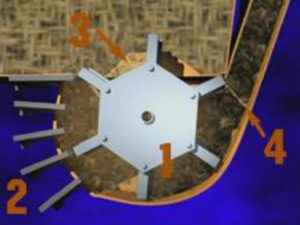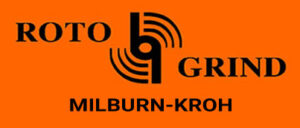Why Choose Roto Grind
Compared to other tub grinders:
- Price – we are about 1/3 the price of machines that come close to our capacity.
- Can grind all the wet and tough materials all others cannot.
- Horse Power requirements much lower = more potential customers (more operators that only have lower Horse Power tractors) and much less fuel used.
- Low maintenance – only 2 moving parts and only 1 wearing part. Hammers now have tungsten carbide hard facing and are reversible all 4 ways.
- More versatile discharge with many options. Allows for grinding into stock piles, covered sheds, trucks, mixers, self feeders, bale rings, feed bunks, and spreading bedding. Our bunk feeder also grinds into a windrow. The swivel attachment fits all spout designs. Our Standard spout design has very little waste compared to a conveyor belt discharge, in windy conditions.
- Easier, faster and lower cost to change length of grind.
- Simple – very effective governor system, allows same machine to utilize tractors from 70 to 200 Horse Power. We can adjust for operating rpms. from 540 to 1100 rpms.
- Attachments for grains and specialty grinding easy to install and operate.
- We do not damage the tractors PTO, drive components and engine because of our design. Our fly wheel style rotor and hammers eliminate shock loads.
- If you ever plug anything, ours can be cleaned out in a few minutes, while screen grinders take much work and hours to unplug.
Advantage over custom grinders:
- Depending on how much you have to grind – purchase or lease a Roto Grind and save money each year.
- Keep your grind fresh. Research shows that ground hay looses nutritional value after 2 weeks, due to many factors such as; weather – snow, rain, wind, sun and exposure to oxygen.
- If you are set up for feeding ground hay, and because of weather, breakdowns, or other problems and your custom grinder can’t make it when you need him, you will put yourself in a very bad feeding position.
- You are at the mercy of how the custom grinder has his machine set. If you want a finer or coarser grind on different hay types, chances are that they will not stop and adjust for you. Since this means changing screens, which is a lot of work.
- If you want to blend different types of hay together while grinding and some of your bales are too tough or wet, such as grass hay, slew hay, cane hay or corn stalks, the custom grinder will not, or can not, always do as you want because their grinders will not handle wet and tough hay.
- Most custom grinders are in such a hurry that most do not remove plastic twine from bales. This is bad for cattle as it will not digest through them. It can cause death or poor performance in beef and dairy cattle. Sheep feeders absolutely cannot feed plastic. Not removing plastic twine leaves a mess with plastic everywhere like feed bunks, manure, yard, etc. Plastic twine does not go away by itself unless you remove it from the bales yourself and dispose of it correctly.
- If it is raining, snowing or blowing when the custom grinder shows up, most times he is on a specific schedule and has to grind anyway. This can waste a lot of your feed and makes poorer quality feed.
Compared to bale processors and etc:
- Bale processors cannot and do not grind or have much control over the length of their cut, especially in coarse forages with thick stems. Therefore cattle do not do as well on long stemmed hay compared to ground hay. (Less nutritional value, and palatability. Less feed conversion to lbs. of beef gain, and more waste).
- If you are feeding from a bale processor onto the ground, you will have significant waste as cattle stomp it into the ground, mud and snow, bed on it, urinate and defecate on it – which will cause herd health problems.
- Cannot grind small grains, ear corn, etc.
- Cannot put into stock piles.
- Cannot blend together poor quality forages with good quality forages.
- Cannot put into trucks or mixer wagons.
- Cannot handle frozen bales without causing damage to their flails, rotors, knives or whatever they use to tear the bale apart.
- All types of twine wraps badly and requires operators to go to drastic measures to remove it, such as burning it off with a blow torch, which causes damage to the machine (bearings, paint, metal, flails).
- Basically they just unbale the bales and don’t do a consistent job of chopping. Many kinds do not handle all sizes of round bales, square bales or loose hay.
Compared to feed mixers and vertical mixers:
- Do not do a consistent job of cutting forage to a uniform length. This does not create a Total Mixed Ration (TMR) when stem length varies to this degree.
- Cost, these are very expensive machines to purchase and maintain.
- If feeding a high hay ration, it can take as long as 20 to 30 minutes per round bale to chop it fine enough to feed out of their unloader system.
- Using slow moving knives, blades, and augers to process baled forages requires very high torques. They work reasonably well when everything is new and sharp but cause much strain on the machine as it wears.
- If the operator mixes too long, most of the forage length gets smashed and too small for most feeding application, especially for dairy TMR feeding.
- They work best for mixing and feeding with low hay rations. For high hay rations, cutting and mixing takes a long time and chop length is very inconsistent (not a true TMR ).
- Wear and maintenance is much higher when using a mixer machine to process hay.
- Pre-grinding your forage to the length you want and then mixing it with your feed ration extends the life of your expensive mixer by 4 to 5 times.
- If your bales weigh 1200 lbs. and you require 400 lbs. per batch, you have to put the bale into the mixer and wait for it to shred enough to unload the extra hay that you do not need. This process wastes a lot of time. Most operators need to be able to mix different weights and batches several times a day. This is very difficult when your bales vary in weight and you cannot adjust your ration to include a whole bale.
- Many feeders who have used these types of mixers are not satisfied with the quality of mix, consistency of the mix, forage lengths, the time it takes to mix and process hay, the cost of these machines, and expense of repairs. They are now realizing that they should pre-process their forages to the length they want to be more efficient at quality mixing and accurate weights per batch while also reducing labor, fuel costs and feeding – mixing time. Using our Roto Grind for a few hours per week solves all of these problems.
Very Few Moving Parts:


- Hammers: 24 free swinging hammers. The hammers are long & heavy for maximum extension in tough conditions. This ensures an even grind in all conditions. The hammers are hard faced with tungsten carbide & they are reversible to utilize all 4 corners.
- Shear Plates: Individually adjustable shear plates give simple, easy control of fineness of grind without the use of screens.
- Riser: The adjustable riser controls the amount of bite the hammers take.
- Mill Housing Door: A hinged door on the housing opens to grind extremely wet materials.
